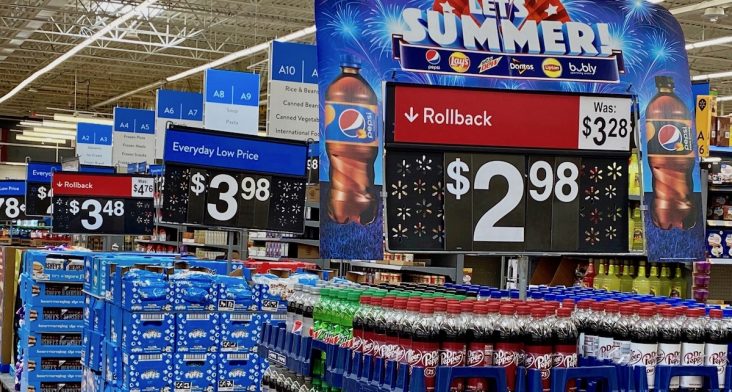Retailers and suppliers work to manage inflation; prices up as much as 9%
by July 13, 2021 2:59 pm 2,340 views

The Federal Reserve estimated consumer prices will jump 3.4% in the fourth quarter compared to last year. Retail food and consumable prices are up between 8% and 9% compared with 2020. Economists say the uptick in prices could add $6,000 to consumer grocery bills this year relative to a year ago.
Many wholesale food commodity prices are experiencing high double-digit and triple-digit percentage gains in pricing as demand is outpacing supply for soy oil up 158% from a year ago. Hog prices have risen 121% and chicken wings prices are up 105%. Pork bellies used in bacon are up 87% from a year ago, corn is 87% more expensive and chicken leg prices are running 86% more than a year ago. Chicken breast costs are up 66% while soybeans are 60% more costly than a year ago. Coffee prices are up 47%, while beef, corn oil and wheat costs are trending about 34% higher than a year ago, according to the Stephens Inc. Commodity report dated July 13.
Retailers like Walmart have said they will leverage their size and strong balance sheet – meaning they might absorb some of the costs – to keep food costs down as more suppliers implement price increases. J.M. Smucker Co., a long-time supplier to Walmart, said it expects higher inflation rates for this year and the beginning of next. The company is increasing consumer prices across the product portfolio while also looking for productivity savings, according to Chief Financial Officer Tucker Marshall.
General Mills recently announced price increases for some or all of their cereal products, noting they will keep an eye on competitors to try and preserve marketshare. Economists expect bigger companies to try and reallocate spending and find cost cuts in other areas to pay for the inflationary prices in the short-term.
Walmart has said it benefits from its scale and global sourcing ability. McCormick, Tyson Foods and Cargill have each tried to limit inflationary pressures on raw materials by trying to stock up when prices are lower.
Walmart U.S. CEO John Furner said in May the retailer had about 30% more discounts in stores in the first quarter than the same period a year ago. He said it plans to continue to dangle deals and widen price gaps to stand out from competitors. He said Walmart will hold the line on low prices and count on frequent sales more often as the nation returns to normalcy. He said consumers are coming back into stores and they will compare prices on everything.
“Over the last 12 months, we saw our price gaps improve versus the market, and our merchants are working hard to ensure that that will continue,” Furner said in the May conference call with analysts.
Dollar Tree has a harder mission as it sells everything for $1. CEO Michael Witynski said the retailer is working to replace items with a new assortment in order to keep prices at $1. Just 37% of the items sold at Dollar Tree are from national brands. Last year the company began to find cost-savings in shipping costs by increasing shipment sizes on best selling items.
Piper Sandler analysts recently downgraded Dollar Tree to a neutral position and lowered the price target from $117 to $102 amid inflationary pressures and rising freight costs. The investor group also said a $1 per hour wage hike would equate to $215 million in incremental costs for Dollar Tree.
Discounter Five Below mostly sells items costing under $5, as the name suggests. Five Below CEO Joel Anderson, a former Walmart executive, said inflation can be an advantage to value discounters because when prices rise or economic conditions worsen it is value that becomes most important to shoppers. He said every retailer is seeing rising costs of goods, transportation and wages and that is squeezing profits. Anderson recently told analysts Five Below began selling more items costing under $10 last year and that is helping combat the margin compression.
RBC Capital Markets analysts recently said value retailers will be challenged with inflation as their core customer base has less means to pay more for food and consumables.
“Inflation is a risk to customer health,” Scot Ciccarelli from RBC Capital Markets, said in a recent investor note. “Food and gas prices continue to rise, which squeezes the wallets of the companies’ existing core customer base.”
Gasoline prices are averaging $3.15 per gallon this week, the most expensive in seven years, as more consumers are hitting the road. Arkansas gasoline prices range from $2.75 per gallon in Bentonville to $2.67 in Fort Smith and $2.68 in Springdale. Little Rock’s lowest price on Tuesday was $2.74. Low prices are also reported at $2.64 in Conway and $2.65 in Jonesboro, according to Gasbuddy.com.
